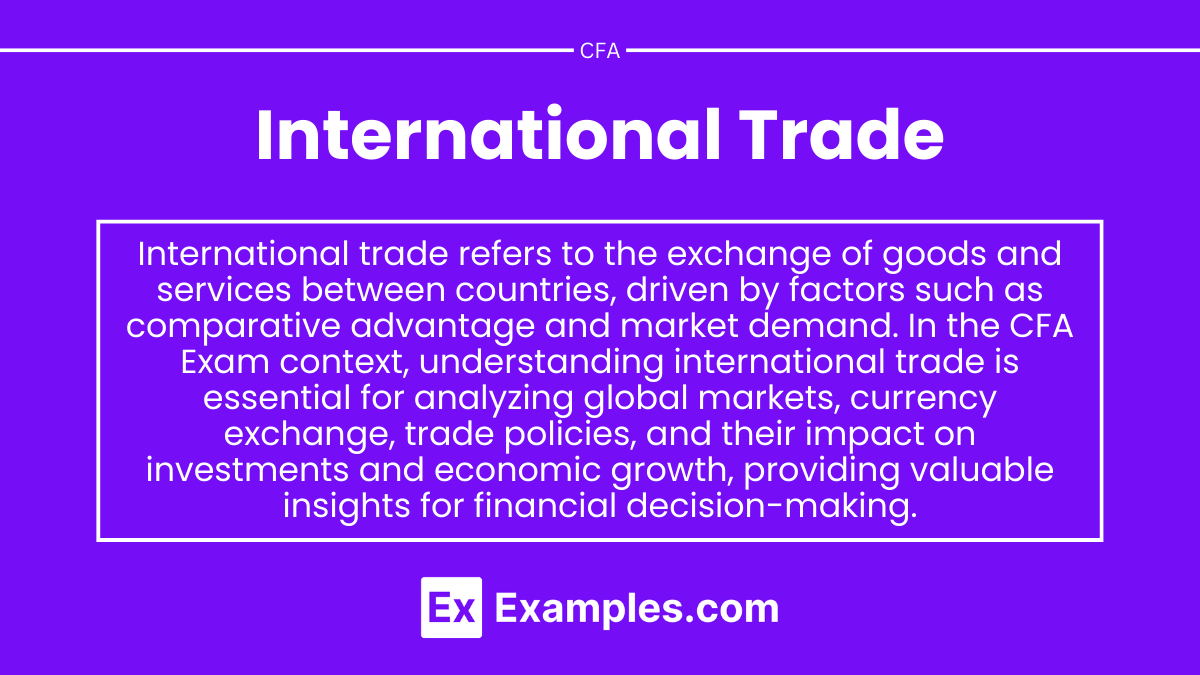International Trade is a critical component of economic analysis, offering insights into the flow of goods, services, and capital across borders. This topic examines the fundamentals of trade theories, the benefits and costs of trade, and the impact of trade policies on global economies. It covers key concepts such as comparative advantage, exchange rates, and trade restrictions, along with the roles of international organizations in facilitating trade. Understanding these elements is essential for analyzing economic interdependencies and assessing the effects of international trade on markets, investment opportunities, and economic growth.
Learning Objectives
In studying “International Trade” for the CFA, you should learn to understand the fundamentals of global trade, including the principles of comparative and absolute advantage, and how they drive trade between nations. Explore the impact of trade policies, such as tariffs, quotas, and subsidies, on domestic and global markets. Analyze the balance of payments and its components, particularly the trade balance, and understand how it affects currency values and economic stability. Evaluate the role of international trade organizations, like the WTO, in promoting trade liberalization and resolving disputes. Additionally, assess the economic and political factors influencing trade agreements and the implications of trade restrictions on investment strategies and risk management in a global context.
Understanding the Fundamentals of Global Trade
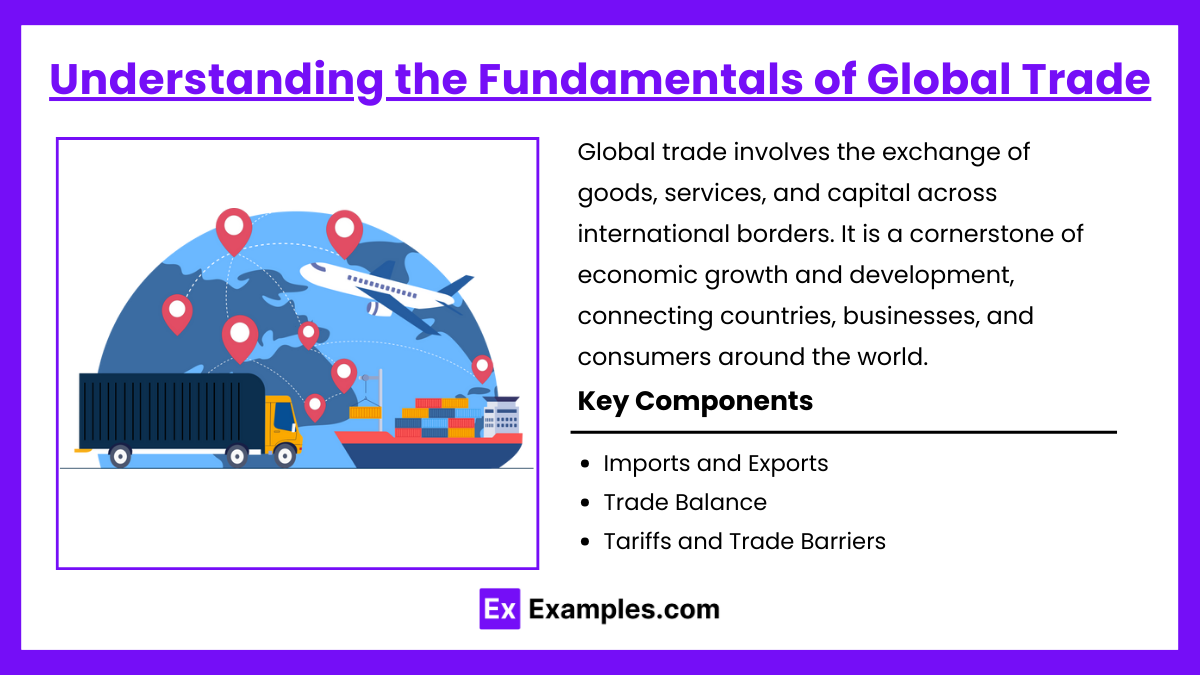
Global trade involves the exchange of goods, services, and capital across international borders. It is a cornerstone of economic growth and development, connecting countries, businesses, and consumers around the world. Understanding the fundamentals of global trade provides insight into how countries collaborate and compete, and it helps explain the economic, political, and social dynamics that shape global markets. Here’s an overview of the key components, benefits, challenges, and mechanisms that drive global trade.
Key Components of Global Trade
Global trade consists of several essential components, each playing a critical role in facilitating cross-border transactions.
- Imports and Exports: The basic units of trade. Imports are goods and services bought by one country from another, while exports are those sold by a country to other nations.
- Trade Balance: The difference between the value of exports and imports. A trade surplus occurs when exports exceed imports, and a trade deficit occurs when imports exceed exports.
- Tariffs and Trade Barriers: Taxes or restrictions on imported goods. These are often used by governments to protect domestic industries but can also hinder free trade.
Example: The U.S. imports electronics from China, creating an import flow, while China benefits from the revenue generated by exporting these goods.
Benefits of Global Trade
Global trade offers numerous benefits for economies, businesses, and consumers.
- Economic Growth: Trade boosts economic growth by allowing countries to access new markets and expand production, increasing GDP and employment opportunities.
- Consumer Choice: Trade provides consumers with a wider variety of goods and services, often at lower prices due to competition and economies of scale.
- Innovation and Technology Transfer: Exposure to global markets promotes innovation and technology transfer as countries and companies learn from each other and adopt best practices.
Example: Access to international markets has helped countries like South Korea and Singapore develop strong export-driven economies, raising their standards of living.
Comparative Advantage and Specialization
The theory of comparative advantage explains why countries engage in trade. It suggests that countries benefit by specializing in the production of goods and services they can produce most efficiently and trading for those they produce less efficiently.
- Specialization: Countries focus on producing goods where they have a comparative advantage, reducing costs and increasing efficiency.
- Trade Benefits: By specializing and trading, countries can access a wider variety of goods and services, improve productivity, and increase national wealth.
Example: Brazil has a comparative advantage in producing coffee, while Germany excels in manufacturing high-quality machinery. By trading, both countries benefit from accessing these products more efficiently.
Exploring the Impact of Trade Policies on Domestic and Global Markets
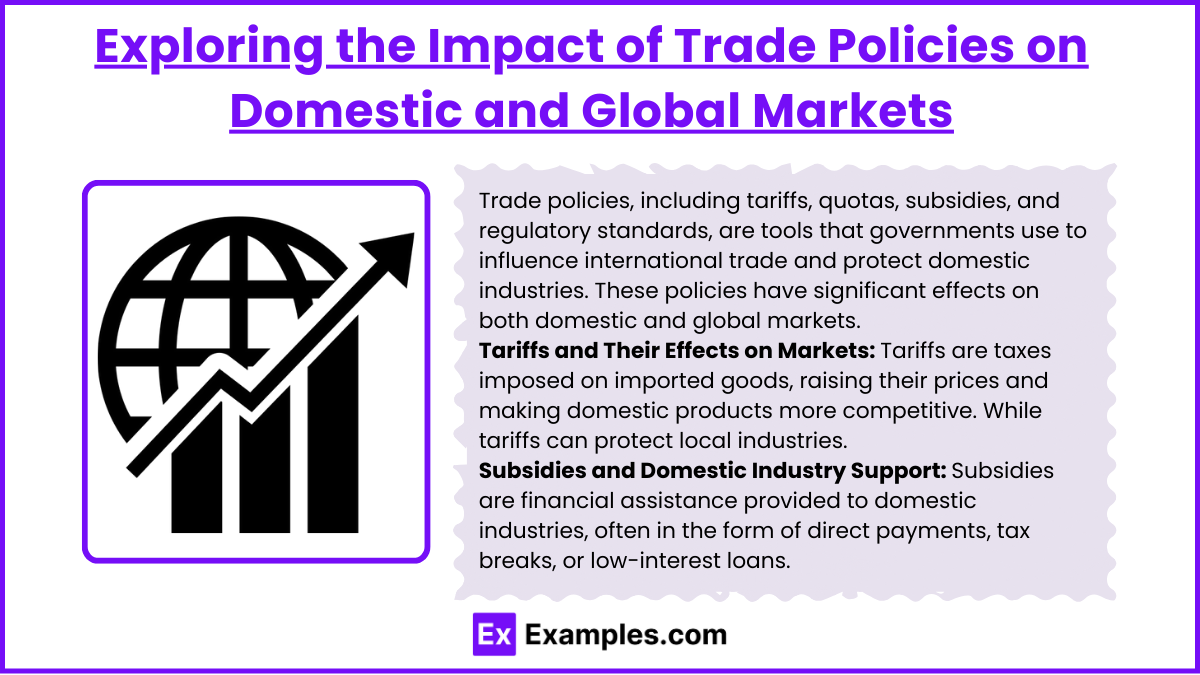
Trade policies, including tariffs, quotas, subsidies, and regulatory standards, are tools that governments use to influence international trade and protect domestic industries. These policies have significant effects on both domestic and global markets, shaping the economic landscape, influencing prices, and affecting employment. Understanding the impact of these policies reveals how they drive economic outcomes and alter trade relationships.
Tariffs and Their Effects on Markets
Tariffs are taxes imposed on imported goods, raising their prices and making domestic products more competitive. While tariffs can protect local industries, they also have wider economic implications for consumers, businesses, and trade partners.
- Domestic Impact: Tariffs benefit domestic producers by reducing foreign competition, potentially increasing local production and creating jobs in protected industries. However, they also raise the cost of imported goods, leading to higher prices for consumers and increasing production costs for businesses relying on imported materials.
- Global Impact: Tariffs can lead to trade tensions, as affected countries may retaliate with tariffs on their own, potentially escalating into a trade war. This creates uncertainty in global markets, disrupts supply chains, and impacts trade-dependent sectors worldwide.
Example: The U.S.-China trade war saw tariffs on a wide range of goods, impacting prices for consumers and businesses in both countries and reducing global trade volumes.
Subsidies and Domestic Industry Support
Subsidies are financial assistance provided to domestic industries, often in the form of direct payments, tax breaks, or low-interest loans. Subsidies enable domestic producers to lower their costs, making their products more competitive both domestically and internationally.
- Domestic Impact: Subsidies help local industries grow, protect jobs, and maintain competitiveness against foreign producers. However, subsidies are funded by taxpayer money and can sometimes lead to inefficiency if industries become dependent on government support.
- Global Impact: Subsidies can distort global trade by artificially lowering the cost of domestic products, making it difficult for foreign competitors to compete. This may lead to trade disputes or retaliatory measures from other countries.
Example: The U.S. subsidizes its agricultural sector, which allows American farmers to sell products at lower prices internationally. However, this practice has faced criticism from developing countries, where farmers struggle to compete with subsidized American goods.
Evaluating the Role of International Trade Organizations
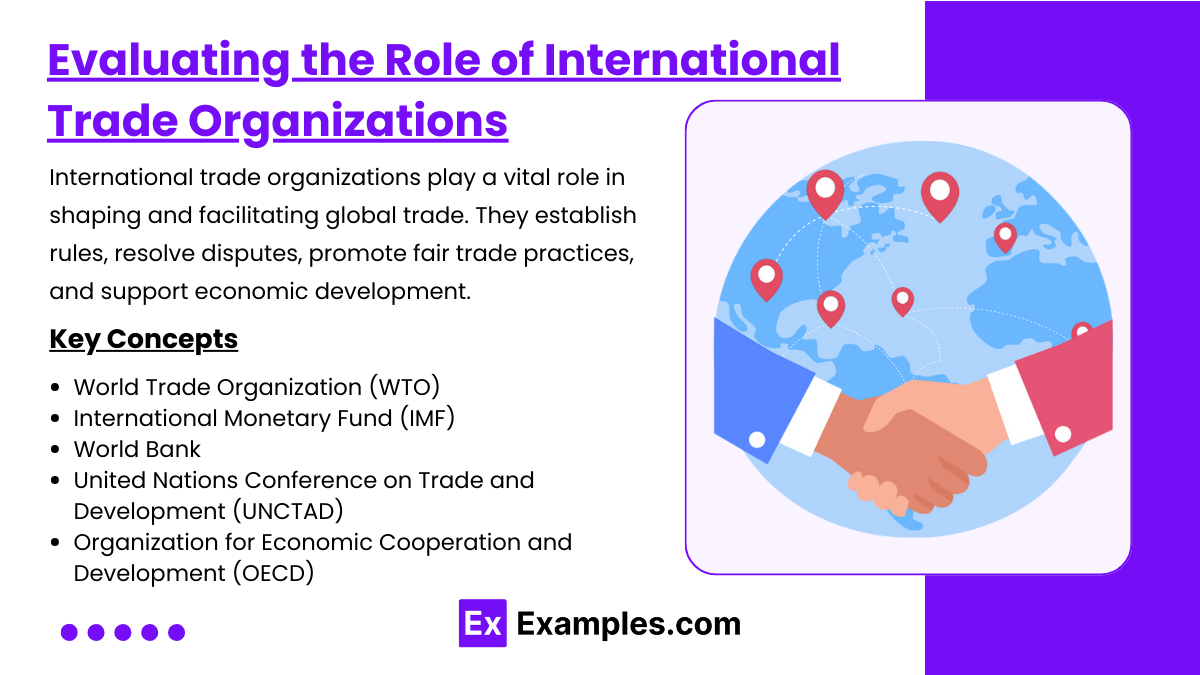
International trade organizations play a vital role in shaping and facilitating global trade. They establish rules, resolve disputes, promote fair trade practices, and support economic development. These organizations provide a platform for countries to collaborate, reduce trade barriers, and manage trade tensions. Here’s a closer look at some of the major international trade organizations, their roles, and their impact on the global economy.
Key Concepts
1. World Trade Organization (WTO)
The WTO is the primary international organization for regulating global trade. It oversees trade agreements, resolves disputes, and promotes fair competition among member countries.
Role:
- Trade Negotiations: The WTO facilitates negotiations to reduce trade barriers, such as tariffs and quotas, making trade more accessible and efficient.
- Dispute Resolution: The WTO provides a structured process for resolving trade disputes among member countries, promoting stability and predictability in global trade.
- Establishing Trade Rules: The WTO sets global trade rules that create a level playing field and reduce unfair trade practices, like subsidies or dumping.
- Impact: By promoting free trade, the WTO has helped increase global trade volumes and economic growth. However, it has faced criticism for prioritizing the interests of wealthier nations and struggling to address the needs of developing countries.
Example: In 2018, the WTO’s dispute resolution system was used to address the U.S.-China trade dispute, with both countries bringing complaints over tariffs and trade practices.
2. International Monetary Fund (IMF)
The IMF primarily focuses on global financial stability, but it also plays a crucial role in international trade by supporting economic stability and providing financial assistance to countries in need.
Role:
- Economic Surveillance: The IMF monitors global economic trends and provides analysis and advice to member countries, helping them manage trade balances and avoid financial crises.
- Financial Assistance: The IMF provides loans to countries facing economic instability, often with conditions to implement economic reforms that improve trade competitiveness and financial stability.
- Capacity Building: The IMF offers technical assistance to help countries improve their financial systems and policies, fostering an environment conducive to trade.
- Impact: By promoting economic stability, the IMF helps create a favorable environment for global trade. However, the conditions attached to IMF loans have sometimes been controversial, as they can require austerity measures that impact social programs and economic growth.
Example: During the 1997 Asian Financial Crisis, the IMF provided financial assistance to affected countries, helping to stabilize their economies and restore confidence in their trade and financial systems.
3. World Bank
The World Bank is an international financial institution that provides funding and technical assistance to support economic development, primarily in low- and middle-income countries.
Role:
- Project Funding: The World Bank finances infrastructure projects, like transportation, energy, and telecommunications, which are essential for expanding trade capacity in developing countries.
- Trade Facilitation: The World Bank works with countries to improve trade logistics and border management, making it easier to export and import goods.
- Poverty Reduction: By supporting economic growth and job creation, the World Bank’s projects help reduce poverty and improve living standards, increasing consumer demand and trade.
- Impact: The World Bank’s funding and expertise have helped many countries build the infrastructure needed for trade and economic growth. However, some projects have faced criticism for environmental and social impacts.
Example: The World Bank funded improvements to port facilities and roads in Africa to reduce transportation costs, making trade more efficient and boosting economic growth.
4. United Nations Conference on Trade and Development (UNCTAD)
UNCTAD is a United Nations body that supports developing countries in accessing the benefits of global trade and reducing trade inequalities.
Role:
- Policy Research and Analysis: UNCTAD conducts research on trade issues affecting developing countries, offering policy recommendations to improve their trade prospects.
- Technical Assistance: UNCTAD provides training and support to help developing countries build trade capacity and implement trade policies.
- Advocacy for Fair Trade: UNCTAD advocates for fair trade practices that address the unique challenges facing developing nations, such as limited market access and high trade costs.
- Impact: UNCTAD’s work has helped raise awareness about the challenges developing countries face in global trade and has promoted policies that aim to reduce trade inequalities. However, its influence is often limited compared to larger organizations like the WTO.
Example: UNCTAD has advocated for debt relief measures for developing countries to enable them to allocate resources to trade and development rather than debt servicing.
5. Organization for Economic Cooperation and Development (OECD)
The OECD is a forum of primarily developed countries that promotes policies aimed at improving economic and social well-being globally, including through trade policies.
Role:
- Policy Coordination: The OECD coordinates economic and trade policies among member countries to create a stable and predictable global economic environment.
- Trade Research and Analysis: The OECD conducts in-depth research on trade issues and provides data, analysis, and policy recommendations to member and non-member countries.
- Trade Facilitation: The OECD supports policies that reduce trade barriers and improve regulatory cooperation, particularly among developed nations.
- Impact: The OECD’s policy coordination has contributed to trade stability and economic growth in developed countries. However, its membership is primarily composed of high-income countries, which can limit its relevance for developing nations.
Example: The OECD provides research and policy advice on digital trade and e-commerce, helping countries adapt to the changing nature of global trade.
Assessing Economic and Political Factors Influencing Trade Agreements
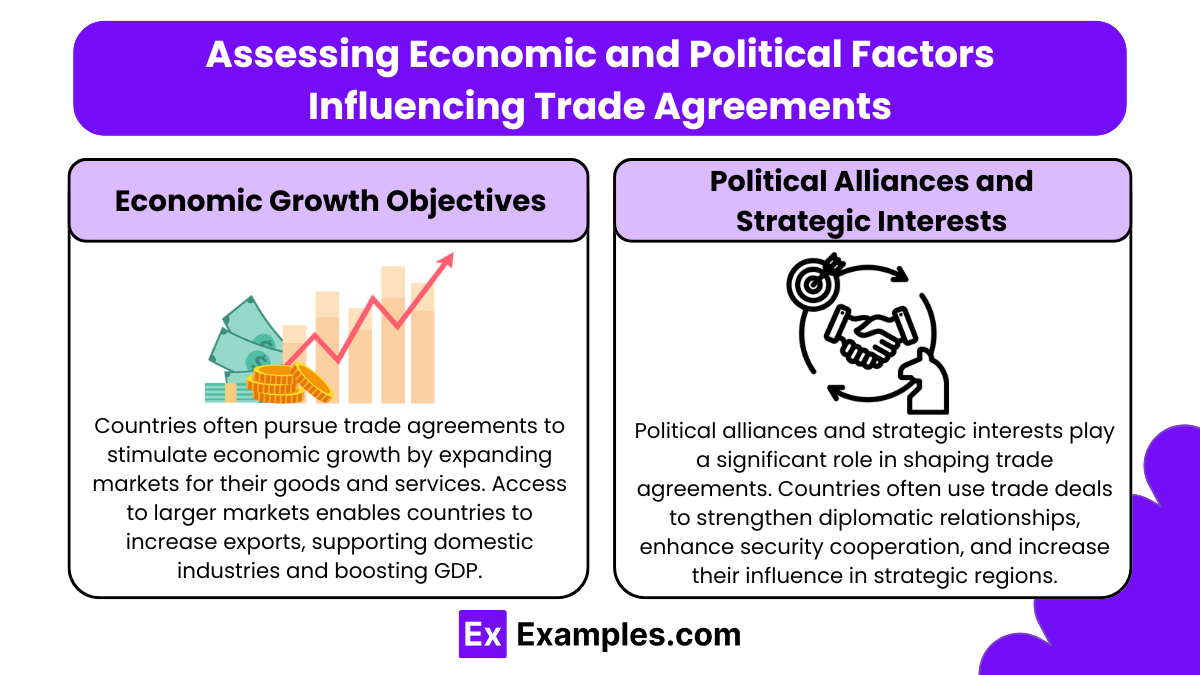
Trade agreements are shaped by various economic and political factors that influence a country’s objectives, priorities, and negotiating positions. These agreements can range from bilateral treaties between two nations to large multilateral agreements that include multiple countries or regions. Understanding these factors helps explain why trade agreements are structured as they are and how they impact both domestic and international economies.
Economic Growth Objectives
Countries often pursue trade agreements to stimulate economic growth by expanding markets for their goods and services. Access to larger markets enables countries to increase exports, supporting domestic industries and boosting GDP.
- Export Opportunities: By reducing or eliminating tariffs and quotas, trade agreements create new export opportunities, helping domestic industries grow and become more competitive.
- Foreign Direct Investment (FDI): Trade agreements encourage foreign investment by providing a stable and predictable trade environment, leading to job creation and economic growth.
- Access to Resources: Trade agreements often include provisions for access to resources like raw materials or energy, which are essential for domestic production.
Example: The Comprehensive and Progressive Agreement for Trans-Pacific Partnership (CPTPP) opens up access to markets across Asia-Pacific, providing opportunities for growth for countries like Japan, Canada, and Australia.
Political Alliances and Strategic Interests
Political alliances and strategic interests play a significant role in shaping trade agreements. Countries often use trade deals to strengthen diplomatic relationships, enhance security cooperation, and increase their influence in strategic regions.
- Building Alliances: Trade agreements can foster alliances, strengthening diplomatic ties and creating interdependencies that reduce the likelihood of conflict.
- Countering Rival Influence: Some trade agreements are designed to counterbalance the influence of rival countries by creating alternative economic partnerships or reducing dependency on rival markets.
- Security Cooperation: Trade agreements often come with strategic security considerations, such as provisions that protect critical industries or support cooperation in defense and technology.
Example: The Trans-Pacific Partnership (TPP), though the U.S. eventually withdrew, was initially conceived as a way to strengthen ties among Pacific nations and counter China’s growing influence in the region.
Examples
Example 1: Exporting Agricultural Products
Many countries engage in international trade by exporting agricultural products, such as coffee, rice, or fruits. For instance, Brazil is one of the largest exporters of coffee in the world. By trading coffee with countries that do not produce it, Brazil benefits from increased revenue while providing consumers access to diverse products, illustrating the interdependence of global markets.
Example 2: Automobile Manufacturing
The automobile industry is a prime example of international trade, with manufacturers sourcing parts from various countries to assemble vehicles. Companies like Toyota and Volkswagen utilize supply chains that span multiple nations, where components such as engines, electronics, and tires are produced. This interconnected production process allows automakers to reduce costs and improve efficiency, showcasing the benefits of global trade networks.
Example 3: Technology and Electronics Trade
Countries like China and South Korea dominate the export of electronics and technology products, such as smartphones, semiconductors, and computers. For example, Apple’s iPhones are designed in the United States but assembled in China using parts sourced from various countries. This illustrates how international trade facilitates the flow of technology and innovation across borders, benefiting consumers worldwide.
Example 4: Textile and Apparel Industry
The textile and apparel industry relies heavily on international trade, with many countries specializing in different stages of production. For instance, Bangladesh is known for its garment manufacturing, exporting clothing to markets in Europe and North America. This trade provides economic opportunities in developing countries while offering consumers access to affordable fashion.
Example 5: Energy Resources
International trade in energy resources, such as oil and natural gas, significantly impacts global economics and politics. Countries like Saudi Arabia export oil to nations that lack domestic energy resources, ensuring a steady supply for energy consumption. This trade is vital for maintaining energy security and influencing geopolitical relationships, highlighting the strategic importance of natural resources in international trade.
Practice Questions
Question 1
What is the primary benefit of international trade for countries?
A) Increased isolation from global markets
B) Access to a wider variety of goods and services
C) Reduction in the number of jobs available
D) Elimination of all tariffs and trade barriers
Correct Answer: B) Access to a wider variety of goods and services.
Explanation: The primary benefit of international trade is that it allows countries to access a broader range of goods and services than they could produce domestically. By engaging in trade, countries can specialize in producing what they are most efficient at and import other products, enhancing consumer choice and promoting economic efficiency. Options A and C are incorrect as they do not reflect the positive impacts of trade, and option D is unrealistic since many countries still implement tariffs and trade barriers.
Question 2
Which of the following concepts refers to a situation where a country can produce a good at a lower opportunity cost than another country?
A) Comparative advantage
B) Absolute advantage
C) Trade surplus
D) Balance of payments
Correct Answer: A) Comparative advantage.
Explanation: Comparative advantage is the concept that describes how a country can produce a particular good more efficiently than another country when considering opportunity costs. This principle is fundamental in international trade, as it encourages countries to specialize in the production of goods where they hold a comparative advantage, leading to more efficient resource allocation and increased overall economic welfare. Absolute advantage refers to a country’s ability to produce more of a good than another country using the same resources, but it does not consider opportunity costs.
Question 3
What is a tariff?
A) A tax imposed on exports
B) A tax imposed on imports
C) A subsidy for domestic products
D) An agreement to eliminate trade barriers
Correct Answer: B) A tax imposed on imports.
Explanation: A tariff is a tax that a government imposes on imported goods. The primary purpose of tariffs is to protect domestic industries from foreign competition by making imported goods more expensive. This can encourage consumers to buy domestically produced goods. While tariffs can generate revenue for the government, they can also lead to trade tensions and increased prices for consumers. Options A and C incorrectly describe tariffs, and option D describes trade agreements, not tariffs.

